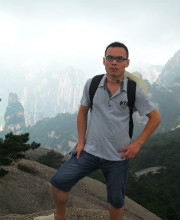| 图片: | |
|---|---|
| 名称: | |
| 描述: | |
- 右肾肿物,新增免疫组化结果。
男,41岁,右肾实性占位。术中见右肾上极一大小约9X8cm的实性占位,包膜完整,中心呈星状瘢痕,行右肾根治术。
大体:灰红色已剖开肾脏一个,大小约17X11X6cm,于肾脏上极建议灰黄色灰褐色肿物,大小约8.5X7X7cm,与周围组织界限明显。
镜下:

名称:图1
描述:幻灯片1

名称:图2
描述:幻灯片2

名称:图3
描述:幻灯片3

名称:图4
描述:幻灯片4

名称:图5
描述:幻灯片5

名称:图6
描述:幻灯片6

名称:图7
描述:幻灯片7

名称:图8
描述:幻灯片8

名称:图9
描述:幻灯片9

名称:图10
描述:幻灯片10

名称:图11
描述:幻灯片11

名称:图12
描述:幻灯片12
-
本帖最后由 快马轻裘 于 2012-02-24 15:41:39 编辑

- 好好学习,天天向上。
球旁细胞瘤
[Clinicopathological study of 4 renal juxtaglomerular cell tumors].
Source
Department of Pathology, Beijing Friendship Hospital, Capital University of Medical Sciences, Beijing 100050, China.
Abstract
OBJECTIVE:
To investigate the clinical characteristics, morphologic and immunohistochemical features, diagnosis, differential diagnosis, histogenesis and prognosis of renal juxtaglomerular cell tumor (JGCT).
METHODS:
Light microscopic observation; immunohistochemical assay of CK8, E-cadherin/CK7, CD10, Vim, Actin, CD34, S100, HMB45, CD31, Chr, Syn and CD117, EM; and follow-up were done on all 4 surgically treated JGCT patients.
RESULTS:
All 4 JGCT were observed in young adult with clinically uncontrolled severe hypertension. Grossly, the tumor was encapsulated and small in size. Microscopically, the tumor cells grew in sheets predominantly, but papillary and onion-like pattern could also be seen. The stroma contained prominent vasculature that consisted of numerous thin-wall vessels clustering around thick-walled vessels. Tumor cells were rather small, polygonal, with slightly eosinophilic cytoplasm and ill-defined cell border. Nuclei were uniform in size but nuclear atypia and mitosis could be seen. Numerous mast cells were scattered among the tumor cells, and tubules were identified in 3 of 4 cases with positive expression of distal tubule marker of E-cadherin/CK7. Tumor cells positively expressed Vim, Actin, calponin, and CD34. All cases presented ultrastructural features of distinct rhomboid-shaped crystal. There was no recurrence or metastasis but hypertension persisted in three during follow-up (mean 37 months) for all 4 JGCT patients.
CONCLUSION:
JGCT, originating from the juxtaglomerular cell, has a distinct benign entity, and it is typically found in young adults with severe hypertension. It has a unique morphology and ultrastructure features and positive immunoreactivity to Vim, Actin, calponin and CD34.
Juxtaglomerular cell tumor of kidney with CD34 and CD117 immunoreactivity: report of 5 cases.
Source
Department of Pathology, Inje University, Sanggye Paik Hospital, Seoul, Korea.
Abstract
CONTEXT:
Juxtaglomerular cell tumor is a rare renal neoplasm. Renin immunohistochemistry and electron microscopic documentation of rhomboid crystals are the primary methods of diagnosing this benign tumor.
OBJECTIVES:
In this retrospective study, we evaluated the morphologic, immunohistochemical, and ultrastructural features of 5 cases ofjuxtaglomerular cell tumor to determine the effectiveness of CD34 and CD117 immunohistochemistry for the diagnosis of this tumor.
DESIGN:
We reviewed 5 cases with clinical, histologic, immunohistochemical, and ultrastructural aspects.
RESULTS:
Three women and 2 men with a mean age of 37.8 years (range, 16-60 years) were included in this study. All patients presented with severe hypertension. All tumors were well circumscribed and ranged from 1.5 cm to 8.5 cm (mean, 4.4 cm). On light microscopic examination, we found solid sheets and nests of tumor cells with oval-to-round nuclei and eosinophilic cytoplasm. Low-power microscopic examination disclosed a hemangiopericytic vascular pattern. Immunohistochemistry results were as follows: vimentin (positive), renin (weakly positive), smooth muscle actin (focal immunoreactivity), and cytokeratin (negative). All 5 tumors were immunoreactive for CD34 and CD117. Electron microscopy revealed rhomboid crystals in the cytoplasm. Postoperatively, 4 patients were normotensive and 1 patient experienced persistent mild hypertension.
CONCLUSIONS:
Our findings indicate that immunohistochemistry for CD34 and CD117 are effective at diagnosing juxtaglomerular cell tumor.Juxtaglomerular cell tumor should be considered in the diagnosis of any renal tumors with epithelioid cells and negative initial cytokeratin immunohistochemistry.
没有一个文献指出球旁细胞瘤肿瘤细胞CK+,只是指出陷入肿瘤内的正常肾脏导管上皮CK+
























